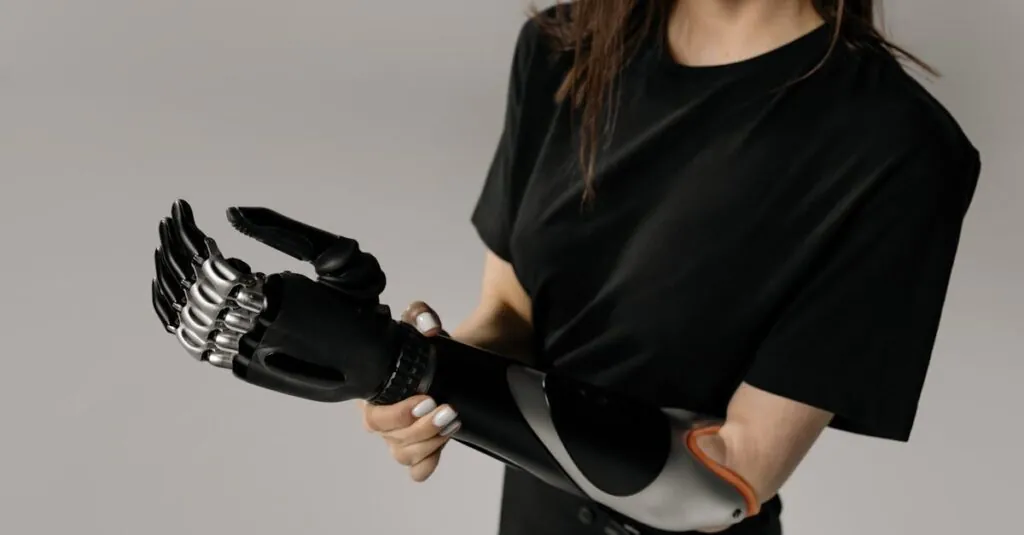Table of Contents
ToggleIn a world where robots are no longer just for sci-fi movies, advanced robotics is stepping into the healthcare arena, and it’s about time! Imagine a surgical assistant that doesn’t need coffee breaks or a nurse that never forgets to check your vitals. These futuristic machines are revolutionizing patient care, making healthcare more efficient and precise.
Overview of Advanced Robotics for Healthcare
Advanced robotics in healthcare enhances efficiency and precision in various settings. Surgery, rehabilitation, and patient monitoring observe significant improvements through the implementation of robotic systems. Surgical robots assist physicians by providing greater accuracy during procedures, reducing recovery time for patients.
Robotic nurses help alleviate workload, allowing healthcare professionals to focus on complex patient needs. Automated systems take over routine tasks such as medication administration and vital sign monitoring, improving overall patient care. Data from studies indicates that robotic assistance leads to fewer complications during surgery, resulting in shorter hospital stays.
Rehabilitation robots facilitate personalized support for patients recovering from injuries. These robots adapt to individual progress, promoting effective therapy sessions. Patients report increased motivation and engagement during rehabilitation when using robotic systems, contributing to better outcomes.
Telepresence robots enable remote consultations, bridging the gap between patients and specialists. This technology allows healthcare providers to diagnose and treat patients from a distance, which proves invaluable in rural or underserved areas. Tracking systems within these robots monitor patient conditions in real time, enhancing remote care quality.
In addition to these applications, advanced robotics fosters research and development in various medical disciplines. Innovations in robotic technologies continue to emerge, further improving healthcare services. By integrating artificial intelligence, robots can learn from vast amounts of data, refining their capabilities over time.
The ongoing evolution of advanced robotics in healthcare signifies a transformative shift in the medical landscape. Each advancement contributes to more effective patient care, ultimately enhancing the healthcare experience.
Applications in Surgery
Advanced robotics have significantly impacted surgical procedures by enhancing precision and safety. Robotics technology introduces new avenues for effective surgical interventions.
Robotic-Assisted Surgery
Robotic-assisted surgery uses sophisticated systems to support surgeons in performing complex tasks. Surgeons manipulate robotic instruments with remarkable precision, often operating through small incisions. Da Vinci Surgical System, a leading robotic platform, allows for enhanced visualization and control. This technology results in reduced blood loss and shorter hospital stays. Studies show that patients experience fewer complications, leading to improved overall outcomes. Surgical teams benefit from advanced training in robotics, further refining their skills.
Minimally Invasive Techniques
Minimally invasive techniques revolutionize the surgical process by reducing recovery times and postoperative pain. Surgeons utilize robotic systems to conduct procedures with smaller incisions compared to traditional methods. Techniques such as robotic laparoscopic surgery minimize tissue damage and enhance recovery experiences. Focused robotics enable surgeons to navigate delicate anatomical structures more efficiently. As a result, patients can return to their daily activities more quickly. Enhanced imaging systems coupled with robotic guidance improve procedural accuracy and patient safety.
Rehabilitation Robotics
Rehabilitation robotics plays a crucial role in patient recovery. These technologies enhance physical therapy by offering personalized interventions.
Robotic Exoskeletons
Robotic exoskeletons assist individuals with mobility impairments. These devices provide support and stability, enabling patients to regain the ability to walk. Clinical studies demonstrate that using exoskeletons leads to significant improvements in lower limb strength. A notable example includes EksoGT, which allows individuals with spinal cord injuries to stand and walk. Continuous use of exoskeletons fosters greater independence, increasing overall quality of life. They deliver effective physical therapy outcomes, promoting motivational engagement in rehabilitation.
Intelligent Assistive Devices
Intelligent assistive devices include a range of robotic systems designed to aid patient therapy. These devices adapt to patient progress, offering tailored feedback during recovery. For instance, devices like robotic arms can assist in repetitive motion exercises, facilitating motor recovery in stroke patients. Research indicates that such technologies enhance patient participation and adherence to rehabilitation programs. Incorporating artificial intelligence, these devices learn from patient movements, continuously improving their support. Overall, intelligent assistive devices serve as valuable tools in enhancing the rehabilitation process and achieving better outcomes.
Impact on Patient Care
Advanced robotics significantly transforms patient care by enhancing surgical precision, safety, and recovery outcomes. Innovative technologies improve healthcare delivery, offering substantial benefits to patients.
Enhancements in Precision and Safety
Robotic-assisted surgical systems provide unmatched precision during procedures. Surgeons operate with enhanced visualization and dexterity through tools like the Da Vinci Surgical System. Procedures conducted with robotic assistance minimize the risk of complications, bolstering overall patient safety. Enhanced imaging systems facilitate accurate targeting of surgical sites, further reducing potential errors. Patients experience fewer adverse events due to these technological advancements, reflecting the importance of robotic integration in modern healthcare.
Improvement in Recovery Times
Recovery times decrease notably with the use of robotic surgery techniques. Patients often leave the hospital sooner, thanks to minimally invasive approaches that lower tissue damage. Surgical methods that incorporate robotics enable a quicker return to daily activities, as associated postoperative pain is significantly reduced. Studies indicate that patients may resume regular routines much faster—sometimes within days—compared to traditional surgical techniques. These rapid recovery times underscore the profound impact of advanced robotics on patient well-being and rehabilitation.
Challenges and Ethical Considerations
Integrating advanced robotics in healthcare presents challenges and raises important ethical considerations. These complexities impact both technology and patient care.
Technological Limitations
Technological limitations hinder the full potential of robotics in healthcare. Many robotic systems lack the adaptability required for diverse patient needs. They may not perform optimally in unpredictable environments, limiting their use during emergencies. Maintenance also poses problems; regular updates and repairs are essential for reliability. Moreover, high costs prevent widespread adoption, particularly in underfunded healthcare settings. Some robotics cannot replicate the nuanced decision-making abilities of human practitioners, which remains critical in complex medical scenarios.
Ethical Implications in Patient Care
Ethical implications shape the integration of robotics in patient care. Privacy concerns arise with data collected during robotic interactions. Patients often worry about the security of their personal health information. Autonomy is another key factor; patients must maintain control over their treatment choices, despite robotic assistance. The potential for job displacement among healthcare professionals complicates the situation, as reliance on robots may reduce human employment opportunities. Ensuring fairness and accessibility becomes crucial, particularly when advanced technology favors certain demographics over others.
Future Trends in Advanced Robotics for Healthcare
Innovations in advanced robotics continue to drive change in healthcare. One prominent trend involves the increasing integration of artificial intelligence in robotic systems. AI enables these robots to learn from patient interactions, allowing for more personalized care approaches. Robotic systems that assist in surgery are evolving, utilizing machine learning algorithms to enhance precision and decision-making during procedures.
Another trend focuses on the development of collaborative robots. These robots work alongside healthcare professionals, improving workflow efficiency. For example, surgical robots can now seamlessly share data with surgical teams in real-time, facilitating better communication and coordination. Enhanced wearables and monitoring devices are also making strides, providing constant feedback on patients’ conditions, thus improving pre- and post-operative care.
Telepresence robotics represents a significant advancement too. These robots enable remote consultations and monitoring, greatly benefiting patients in rural areas with limited access to medical professionals. As telehealth expands, integrating telepresence robots into patient care will likely become standard practice.
The market for rehabilitation robotics is also set to grow. Companies are developing more sophisticated exoskeletons that adapt to individual user needs, further promoting patient mobility and independence. Clinical trials indicate these devices can enhance recovery outcomes for stroke patients, fostering a quicker return to normal activities.
Lastly, ethical frameworks surrounding robotics are gaining attention as this field progresses. Defining clear guidelines ensures responsible use while addressing concerns about privacy and patient autonomy. Increased collaboration among healthcare professionals, engineers, and ethicists focuses on maintaining fairness and accessibility within robotic technologies.
The rise of advanced robotics in healthcare marks a pivotal shift towards improved patient outcomes and operational efficiency. These innovations not only enhance surgical precision but also revolutionize rehabilitation methods and patient monitoring. As the integration of artificial intelligence continues to evolve, healthcare professionals can expect even more personalized and effective care solutions.
While challenges like ethical considerations and technological limitations remain, the potential for positive impact is immense. Embracing these advancements can lead to a more accessible and equitable healthcare system. The future of healthcare is undoubtedly intertwined with robotics, promising a more efficient and compassionate approach to patient care.




